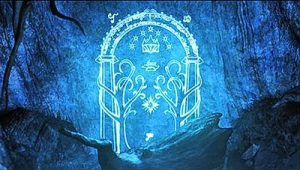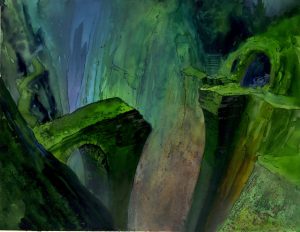The recent reveal of an official synopsis for Amazon Prime’s The Lord Of The Rings adaptation has left us all excited to jump back into Middle-earth and revel in the many joys it has to offer us. But to get fully prepared for Amazon’s upcoming series requires more than just a movie marathon or even a reread of J.R.R. Tolkien’s The Lord Of The Rings – Amazon is pulling from Tolkien’s extensive deep lore for their series, and diving into regions of Middle-earth previously unexplored by either the films or main books.

But chances are you’ve probably heard of Moria, at the very least: out of all the locations prominent in the Second Age of Middle-earth, the lost underground kingdom of the Dwarves is one of the few that still plays a major part in The Lord Of The Rings itself, albeit mostly as a richly layered backdrop to the death of Gandalf the Grey and the reappearance of Gollum. Peter Jackson’s adaptation of The Fellowship Of The Ring immortalized Moria as a soaring CGI spectacle unlike anything audiences in 2001 had ever seen before. And since then, the “You Shall Not Pass” meme of Gandalf defending the Bridge of Khazad-dûm has seeped into popular culture so that, even if you don’t know the accursed name of Moria, you’ve probably already been introduced to it at some point, somehow.
But onscreen thus far (and for that matter in Tolkien’s writing, and in most artwork) Moria has only been depicted in its ruined state, as it appeared to the Fellowship when they passed through in the year 3019 of the Third Age, seeking shelter from the inhospitable Misty Mountains. Amazon’s series, set in the Second Age of Middle-earth, will take us back to a time long before the ruins and the rumors of the dreadful Balrog sleeping in the dark heart of the mountains, before the name of “Moria” was even coined to refer to the Black Pit once known far and wide by its true name – Khazad-dûm, the greatest kingdom of the Dwarves, and the seat of their entire civilization.
And I, as your Middle-earth tour guide for today, will take you back still further, to the First Age and the founding of Khazad-dûm in the darkness before the first dawn. Middle-earth, at this early point in history, made up only half of what was then still a flat, disc-shaped world – the other half being Valinor, the blessed land of the Gods (named Valar, in Tolkien’s mythos). But while Valinor was eternally basked in light, Middle-earth was shrouded in ceaseless darkness save for the faint and far-off light of the stars (the sun and moon had yet to be created, which should give you a sense of how far back in time we’re talking). The Valar, under the guidance of Eru Ilúvatar, had ordained that the Elves should be the first people to inhabit this strange world, and Dwarves didn’t ever come into their equations.
Dwarves were instead conceived by Aulë, one of the Valar who was most impatient for the arrival of the Elves and decided to create life of his own to populate Middle-earth in the meantime. Aulë created seven Dwarves out of clay and stone before Eru found out and admonished him for going against His plan. Aulë was reluctantly prepared to unmake his creations, but Eru was merciful and told Aulë to instead put the Dwarves to sleep until after the coming of the Elves. So Aulë traveled across Middle-earth and laid the seven Fathers of the Dwarves under deep mountains in the wilderness where they would neither be disturbed nor disturb Eru’s plan.
The plan went smoothly. After the Elves had awoken and dispersed across the world, it was time for the Dwarves to follow in their footsteps. Of the seven Fathers, Tolkien only recorded the journey of one – Durin, who awoke first underneath Mount Gundabad in the Misty Mountains, and migrated southwards through uncharted lands. His journey only ended after he discovered a lake beneath the mountains’ shadow, which he named Kheled-zâram in honor of the crown of stars reflected in its clear waters. Durin took this reflection as a sign of his kingship over the Dwarves, and he began the building of Khazad-dûm just west of the lake to be his home, and the home of all the House of Durin (also known as the Longbeards). Durin was called the Deathless, not because he was immortal, but because it was believed that he would be reincarnated seven times among his descendants. One of these later Durins, Durin III, was King of Khazad-dûm during the formative years of the Second Age.

Throughout the First Age, Khazad-dûm expanded further westwards until there were entrances to the city on both sides of the Misty Mountains – but it was still far to the east of most Elven settlements in those days, and the Elves in Middle-earth had fewer dealings with Durin’s folk than with the Dwarves who lived in the cities of Belegost and Nogrod under the Blue Mountains. Khazad-dûm therefore escaped the wars between the Elves and their great nemesis Morgoth, and the violence between Elves and Dwarves that erupted frequently over treasures valuable to both. But when the First Age ended in calamity, and Belegost and Nogrod (and a good chunk of Middle-earth) were sent crashing into the sea, Khazad-dûm gladly opened its doors to the survivors from both cities: much to the benefit of their own civilization and culture, which flourished under the mountains. A string of Dwarven cities and settlements grew under the Misty Mountains, between Khazad-dûm in the south and Gundabad in the far north.
In the wreck of the world, many High Elves were also forced into closer proximity with the Dwarves who had long been their enemies, though it was only in the kingdom of Eregion, near the western entrance of Khazad-dûm, that this intermingling of the two peoples resulted in harmony rather than conflict. Eregion’s king, the craftsman Celebrimbor, was awestruck by the Dwarves and their mighty works of stone beneath the earth, and he eagerly struck up an alliance with them. Together with the Dwarven blacksmith Narvi, he built the great doors in the western wall of Khazad-dûm through which the Fellowship would pass thousands of years later: they were adorned with the intertwined symbols of the House of Durin and the House of Fëanor, Celebrimbor’s grandfather (and you wonder why I ship Celebrimbor and Narvi?). The Dwarves helped Celebrimbor as well, sharing with him much of their most precious resource, the exceedingly strong metal known as mithril, or “Moria-silver” as it was later called, which could only be found far below Khazad-dûm, in mines that reached deep into the fiery heart of Middle-earth. Mithril was used to decorate all the high halls of the Dwarves as well as their weapons and armor; an alloy of it named ithildin went into the making of the western doors; and Celebrimbor forged the ring Nenya out of it, so that it shone like a star.
But the rings were Celebrimbor’s downfall. With the help of a seemingly benevolent stranger named Annatar, Celebrimbor designed his Rings of Power to heal Middle-earth’s hurts and wipe clean its stain of sorrow. They forged sixteen Rings, almost all of which were intended to be distributed among the Elves – but Tolkien played with the idea that Celebrimbor personally presented one Ring to Durin III. Certainly that story seems more likely than the alternative, which would be that Annatar, after having revealed himself as the dark lord Sauron, betrayed and brutally murdered Celebrimbor, and stolen all but three of the Rings of Power, decided to give one to Celebrimbor’s closest ally. It would also lend special significance to Sauron’s later hunt for the ring given to Durin III, which would finally be ripped from the hand of Durin’s descendant Thráin in the dungeons of Dol Guldur during the Third Age – as that would then be the only Ring (besides the Three made without his knowledge and given to the Elves) that he had never previously controlled. Either storyline has potential for good drama, to be honest.
After Sauron ransacked Eregion in search of the Rings, Khazad-dûm was forced to shut its western doors, which had long stood open as a sign of friendship and trust between Elves and Dwarves. Durin’s folk stayed secluded throughout the rest of the Second Age, mostly pursuing a policy of isolationism. But without Khazad-dûm guarding the Misty Mountains, orcs crept back into caverns and tunnels they had long abandoned out of fear of the Dwarves, and became emboldened to launch a successful conquest of Mount Gundabad, the birthplace of Durin. Thus, by the time Khazad-dûm reopened its gates at the end of the Age and sent forth armies to help defeat Sauron in the War of the Last Alliance, it was already too late for the Dwarves to recapture much of the underground empire they had lost.
By the beginning of the Third Age, Khazad-dûm’s glory days were well behind it, and the Dwarves were forced to dig ever deeper for mithril. Nonetheless, it took them almost two-thousand years before they dug slightly too far – and awoke something that had been lying coiled in slumber beneath the roots of the Misty Mountains for millennia. It was a Balrog, a demonic entity of flame and shadow that had served the dark lord Morgoth in the First Age, and fled under the earth’s crust during the breaking of the world (Tolkien never mentions this, but it must therefore have also slept through the end of the Second Age, when Middle-earth was transformed from a flat disc into a globe, and as a fellow heavy sleeper I can relate to that so much). The Balrog erupted into Khazad-dûm, killing King Durin VI and his son, and forcing the survivors to flee into the wilderness on both sides of the Misty Mountains.

And from thence on, the empty city was known by the name of Moria, and its people led lives in exile, whether in the Blue Mountains west of the Shire or in new kingdoms such as Erebor and the Iron Hills. Moria fell into waste and ruin, while Sauron’s orcs and goblins plundered the wreckage for treasures – particularly mithril, which Sauron coveted. The Balrog remained awake, roaming the deepest halls of the Dwarves in silence, worshipped as a god by Sauron’s minions. An attempt to retake Moria, led by Balin of Erebor, was met with stiff resistance from the orcs – who eventually slew the old Dwarf while he bent to look into Kheled-zâram. Balin’s small band of colonizers was whittled down until all were starved or killed, and Moria returned to darkness.
Peter Jackson’s trilogy simplifies the story ever so slightly, implying (just vaguely enough that most book purists don’t get upset) that Moria had only recently been desecrated when the Fellowship passed through, and that under King Balin it had flourished. In truth, Balin’s reign over Moria was very brief and unremarkable: a doomed attempt to rebuild amongst the ruins of an unattainable ancient grandeur, and to recapture some fragment of the city’s long-gone splendor.